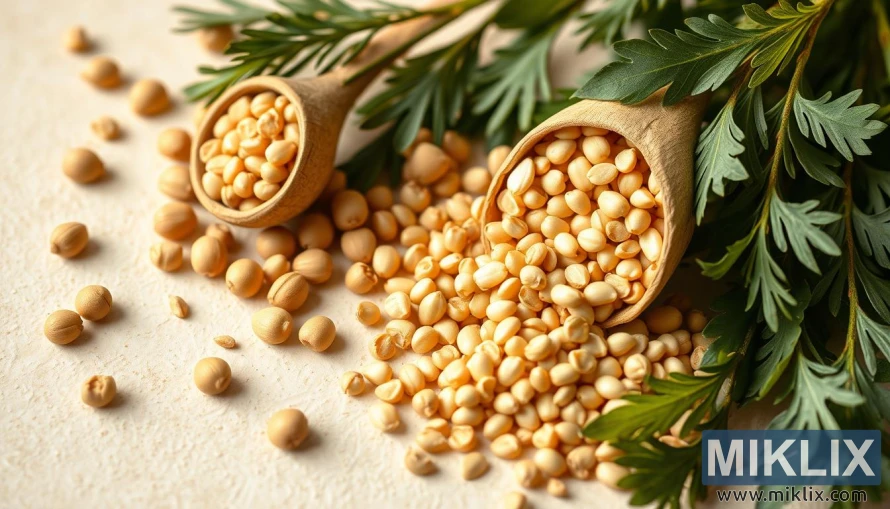Image: Fresh Fenugreek Seeds and Leaves
Published: April 5, 2025 at 5:14:51 PM UTC
Last updated: September 24, 2025 at 4:22:58 PM UTC
High-resolution close-up of fenugreek seeds, pods, and leaves under warm lighting, showcasing their vibrant texture and rich nutritional properties.
The image provides a beautifully detailed close-up of fenugreek seeds and foliage, arranged with careful attention to both naturalism and visual harmony. At the heart of the composition are two small wooden scoops filled with golden fenugreek seeds, their rounded shapes glistening under the soft warmth of natural light. The seeds, slightly varied in size and hue, range from pale amber to deeper honey tones, and their smooth, slightly textured surfaces give them an almost tactile presence. Some seeds have spilled from the scoops onto the light, neutral background, creating a sense of abundance and organic flow that reinforces the idea of nature’s generosity. This scattering also lends the image a dynamic quality, making the scene feel less staged and more like a glimpse into a natural kitchen or herbal preparation space.
Surrounding the seeds are vibrant green fenugreek leaves, their delicately serrated edges and lush appearance providing a striking visual contrast against the warm golden color of the seeds. The leaves fan outward, framing the central subject in a way that draws the eye naturally toward the seeds, while at the same time emphasizing the living plant from which they originate. The fresh, verdant tones of the leaves highlight the vitality and healthful qualities associated with fenugreek, underscoring its reputation as both a culinary spice and a medicinal herb with centuries of use in various cultures.
The interplay of light and shadow across the composition enhances its depth and realism. The warm lighting illuminates the seeds, accentuating their golden glow, while also creating subtle highlights on the leaves, making them appear lively and crisp. This careful use of lighting not only showcases the textures and natural beauty of the fenugreek plant but also conveys a sense of purity and freshness, ideal for emphasizing the herb’s association with health, nourishment, and holistic well-being.
Beyond its aesthetic appeal, the image also serves to symbolize the many ways fenugreek contributes to both diet and medicine. The seeds, which are often used in cooking for their slightly bitter, nutty flavor, are rich in protein, fiber, and essential vitamins. They have been celebrated across traditional systems of medicine for their ability to support digestion, regulate blood sugar, and promote overall metabolic health. The inclusion of the fresh leaves reminds the viewer that fenugreek is not only valued for its seeds but also for its foliage, which is often used as a leafy vegetable in various regional cuisines. Together, the seeds and leaves represent the plant’s versatility and the holistic approach it embodies, bridging the worlds of nourishment and healing.
The background, kept clean and understated in a light, neutral tone, allows the seeds and leaves to stand out in sharp focus. Its simplicity ensures that the viewer’s attention remains on the fenugreek itself, enhancing the clarity of the subject matter. This minimalist backdrop, paired with the rustic charm of the wooden scoops, suggests a timeless connection between the natural world and human use of plants for sustenance and wellness.
Altogether, the image conveys more than just a close-up of seeds and leaves—it evokes the enduring story of fenugreek as a plant deeply woven into human culture, nutrition, and medicine. The seeds spilling naturally across the surface, the vibrant leaves framing the scene, and the soft, golden light combine to create a composition that feels alive, abundant, and rooted in tradition. It is a visual celebration of fenugreek’s resilience and its vital role as a source of nourishment and health, captured in a moment that highlights both beauty and substance.
The image is related to: Fenugreek Benefits: How This Ancient Herb Can Transform Your Health

